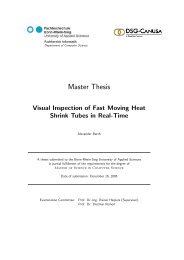Master Thesis - Hochschule Bonn-Rhein-Sieg
Master Thesis - Hochschule Bonn-Rhein-Sieg
Master Thesis - Hochschule Bonn-Rhein-Sieg
Create successful ePaper yourself
Turn your PDF publications into a flip-book with our unique Google optimized e-Paper software.
2. Overview on human-robot <strong>Master</strong> <strong>Thesis</strong> Björn Ostermann page 13 of 126<br />
While the camera was used to detect humans in the workspace and reduce the robot’s operation speed<br />
in the near vicinity of the human, the 3D laser scanner results were used for path planning. Due to the<br />
usage of only one 3D scanner, the robot arm induced blind spots in the environment.<br />
Also a contribution to MORPHA was made in 2004 by Stopp et al. [11]. They used multiple laser<br />
scanners and a 360 degree overhead camera on the DaimlerChrysler Manufacturing Assistant, a<br />
normal industrial robot by Reis GmbH & Co. KG Maschinenfabrik, mounted on a mobile platform.<br />
The software created static and dynamic protective fields, based on the current task and position,<br />
which caused the robot to slow down if approached, up to the point of standing still without an<br />
emergency stop. The system also included a force sensor in the endeffector that allowed the program<br />
to detect, if a human was trying to acquire the object currently held by the robot, in which case the<br />
object was released.<br />
2.2.2 Phriends<br />
From October 2006 till September 2009 the Phriends (Physical Human Robot Interaction –<br />
depENDability and Safety) project [45] is conducting research on physical human-robot interaction.<br />
The DLR (German Aerospace Center) and KUKA Roboter GmbH, both participants in the MORPHA<br />
project, also take part in this project. Part of this work is the investigation into the field of safe<br />
interaction of humans and robots without any separation in time or place. To acquire this grade of<br />
collaboration the robot has to be outfitted with force sensors.<br />
A first result of this project is the KUKA lightweight robot [53]. This seven degrees of freedom<br />
industrial joint arm robot is equipped with integrated sensitivity sensors, that allow the robot to follow<br />
human guidance and detect impacts. Impact tests at 2m/s were conducted, which show that the robot<br />
combined with its control does only minimal hurt to the human body.<br />
At present the Phriends team is working on solutions using two 2D cameras, one to observe the area<br />
and one mounted to the robot for close observation.<br />
2.2.3 Simero<br />
Safety strategies for human-robot-cooperation (SIMERO [51]) is a project of the University of<br />
Bayreuth. This project is supervised by Prof. D. Henrich and based on his approach [10] from 2002.<br />
The sensor used in this project is a multi 2D camera system, where all cameras are placed strategically<br />
in the working area. The different angles of the camera were chosen to minimize the occlusion by<br />
dynamic objects and the robot itself. This allows the robot to evade the human horizontally and<br />
vertically.<br />
While some problems have been solved during the course of the project, in 2008 changes in the<br />
lighting conditions in the environment still cause difficulties. Along with pre-processing cameras and a<br />
new approach on path planning, these difficulties will be addressed in the future work of the project<br />
[13].














